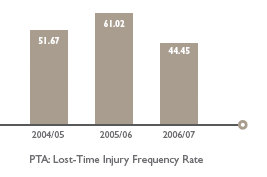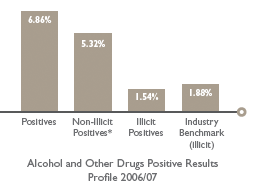SAFETY
The strong focus on safety as a core value of the organisation continued during the year. Representatives of the safety teams from across the PTA had a strategic safety planning day and identified six key focus areas which formed the Health, Safety and Environment (HSE) Strategic Directions for the year. This document is updated annually and endorsed by the Executive Safety and Environment Management Committee to ensure a continued focus on strategic safety management.
RAIL SAFETY
1. Accreditation
A major step was undertaken in overhauling the safety management system to meet the new requirements of AS 4292 and the anticipated national changes to rail safety requirements, including fatigue management, risk management and safety cultural programs.
2. Compliance Inspections and Reporting
The annual rail safety compliance audit was conducted by the Office of Rail Safety in November 2006 and a report was issued on 27 November 2007. The Rail Safety Audit found three non-compliances and 27 observations, compared with seven non-compliances and 23 observations the previous year. All non-compliances and observations were closed out at 30 June 2007.
3. Inquiries and Inspections
There was one investigation involving Category A incidents requested by the Office of Rail Safety under Section 39(3) of the Rail Safety Act. The incident involved a collision between a passenger train and a person in a wheel chair at Carlisle Station in April 2007.
4. Notifiable Occurrences
During the year there were 16 Category A and 627 Category B incidents reported to the Office of Rail Safety during 2006/07. This compares with 18 Category A and 587 Category B incidents in 2005/06.
OCCUPATIONAL SAFETY AND HEALTH
Several safety and health programs were introduced during 2006/07, including the launch of the HSE Handbook for employees; introduction of the Safety Topic of the Month campaign and launch of the “Safety STAR (Stop; Think; Assess; Respond)” marketing and hazard management program. These initiatives complement the organisation’s long-term safety cultural change program.
The functioning of safety committees was improved by the implementation of a new procedure and structural framework. Safety and Health Representatives attended introductory and refresher training courses as they were elected or re-elected.
1. Training
Training in safety and health continued to be a priority, with many managers and supervisors completing a two-day training course on their occupational safety and health responsibilities. A contingent of PTA’s Safety and Health Representatives, as well as several supervisors, managers and safety coordinators, also attended the 2006 WorkSafe Forum where they heard from and questioned a panel of safety experts and presenters on various topics.
Several new in-house training programs were developed this year, including a half- and full-day corporate Health Safety and Environment (HSE) inductions for administrative and operational staff respectively, as well as a full-day, interactive training course in conducting HSE investigations. PTA coordinated two one-day workshops on Human Factors in Transport, which were facilitated by Dr Matthew Thomas of the Centre for Sleep Research, University of South Australia. The workshops included attendees from PTA, as well as representatives from key contractors, service providers and other stakeholders, including the Office of Rail Safety. Training was also initiated across the organisation on bullying, violence and aggression.
2. OSH Reporting System
The PTA’s OSH reporting system, which was launched on 1 July 2004, enables the organisation to capture reported hazards, near-misses and incidents, and facilitates interrogation of data to analyse trends.
Several improvements and additions were made to the system in 2006/07, including an action register to track high-level actions arising from audits and investigations and a health assessment form which enables electronic capture and notification of health assessment results and review requirements for all employees.
Two trials were also begun of paper-based hazard report forms that are entered into the electronic system by a central contact, to enable field-based staff to contribute to the proactive reporting and control of hazards. These trials will be evaluated during 2007/08 for consideration of roll-out to the wider organisation.
Planning and preliminary development was completed for the re-design of the electronic incident report form in the 2007/08 financial year.
3. Injury Management
Injury prevention and injury management continues to be a focus for the PTA.
Previously implemented changes to the PTA’s injury management procedures, including more transparent systems of work, proved to be helpful when managing long-term claims and reducing conflict during the management of claims. To support the continued development of injury management, a review of all procedures was conducted to ensure they were current and met the requirements of regulation and codes of practice.
Despite a significant increase in the number of hours worked, due to an increase in the number of employees, PTA’s 2006/07 injury frequency rates are the lowest in 3 years. The lost-time injury frequency rate for the organisation for the year was 44.45 per million hours worked compared to 61.02* in 2005/06. The average duration for employees with lost-time injuries returning to work increased slightly this year to 20.81 days from 14.65 in 2005/06 due to 4 long term injuries. In addition to these claims, proactive management of smaller issues that were progressing to claims reduced the number of claims that were made.

* Adjusted due to time lost post 30 June 2006
4. Health Assessment Standards
On July 1 2004, the National Transport Commission introduced the National Standard for Health Assessment of Rail Safety Workers. The Standard applies to all rail safety workers as defined in the Rail Safety Act. It relates to health assessments and procedures for monitoring the health and fitness of workers to perform rail safety duties.
Regular updates continued to be provided across the organisation this year, to ensure the currency of safety critical health assessments was maintained. To assist with this goal, a project transferring all health assessment records from the PTA’s human resources records system to a custom-built section of the Safety reporting system was completed in 2006/07. The new arrangement resulted in a reduction in the number of health assessments not completed by their due date.
5. Testing for Alcohol and Other Drugs
Random and “for cause” testing of employees and contractors for alcohol and other drugs continued throughout the year as part of the organisation’s alcohol and other drugs management program.
The PTA’s positive results for illicit substances were again below the industry average. Of the 714 random tests conducted, 11 positive results due to illicit substances were recorded. Only one of the illicit positive results was for a direct PTA employee, the remaining 10 were for contractors. No illicit positive* results were recorded following “for cause” (post-incident) tests. The organisation continues to monitor trends in alcohol and other drug use to ensure that its awareness sessions reflect these trends, thus maintaining relevance and maximising their impact.

* non-illicit positives include over-the-counter or prescribed medications (supported by doctor’s letter)



